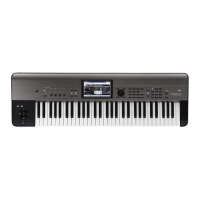PROG P3: Filter 3–5: Filter1 EG
33
Slope [0L (Linear), 1...9, 10E (Exp/Log)]
This sets the curvature of the Slope segment ‐ the transition
from the Break level to the Sustain level.
Release [0L (Linear), 1...9, 10E (Exp/Log)]
This sets the curvature of the Release segment ‐ the
transition from the Sustain level to the Release level.
3–5c: EG Level/Time Modulation
Level
These settings let you use any AMS source to control the
Level parameters of the EG. The Start, Attack, and Break
levels share a single AMS source, but can each have different
modulation intensities.
By using different settings for each of the three levels, you
can cause both subtle and dramatic changes to the EG shape,
as shown below.
Once an EG segment begins, it can’t be modulat-
ed
Once the EG has started a segment between two points, that
segment can no longer be modulated. This includes both the
time of the segment, and the level reached at the end of the
segment.
For instance, if the EG is in the middle of the Decay time,
you can no longer modulate either the Decay time or the
Break level.
As another example, let’s say that you’ve assigned the
Common LFO to modulate Break Level. The LFO may be
moving all the time, but the Break Level is only affected by
the LFO’s value at the instant that the Decay segment starts.
After that, the level is fixed.
Finally, this also means that modulating the Start level,
Attack level, or Attack time will not affect notes that are
already sounding, unless the EG is then reset via AMS.
Filter EG Level Modulation
AMS [List of AMS Sources]
Selects an AMS source to control the EG’s Level parameters.
For a list of AMS sources, please see “AMS (Alternate
Modulation Source) List” on page 340.
St (Start) [–99...+99]
This controls the depth and direction of the AMS
modulation for the Start level.
For example, if you set the AMS source to Velocity and set
St (Start) to +99, the Start level will increase as you play
harder. If you instead set St (Start) to –99, the Start level will
decrease as you play harder.
At (Attack) [–99...+99]
This controls the depth and direction of the AMS
modulation for the Attack level.
Br (Break) [–99...+99]
This controls the depth and direction of the AMS
modulation for the Break level.
Time
These settings let you use three different AMS sources to
control the Time parameters of the EG. For each of the three
AMS sources, the Attack, Decay, Slope, and Release times
each have their own modulation intensities.
Filter EG Time Modulation
AMS1 [List of AMS Sources]
Selects the first AMS source to control the EG’s Time
parameters. Velocity and Keyboard Track can both be useful
here, for instance.
For a list of AMS sources, please see “AMS (Alternate
Modulation Source) List” on page 340.
At (Attack) [–99...+99]
This controls the depth and direction of the AMS
modulation for the Attack time.
For example, if you set the AMS source to Velocity and set
At (Attack) to +99, the Attack time will get much longer at
higher velocities. If you instead set At (Attack) to –99, the
Attack time will get much shorter at higher velocities.
When the AMS source is at its maximum value for instance,
when Velo cit y is at 127 a setting of +8 will make the Attack
time almost twice as long, and a setting of –8 will cut the
Attack time almost in half. (See page 342)
Dc (Decay) [–99...+99]
This controls the depth and direction of the AMS
modulation for the Decay time.
Sl (Slope) [–99...+99]
This controls the depth and direction of the AMS
modulation for the Slope time.
Rl (Release) [–99...+99]
This controls the depth and direction of the AMS
modulation for the Release time.
AMS2 and AMS3
These select the second and third AMS sources, respectively,
for controlling the EG’s Time parameters. Each has its own
intensities for Attack, Decay, Slope, and Release. The
parameters of both AMS2 and AMS3 are identical to those of
AMS1, above.
Original Shape
Positive AMS on Start and Break,
Negative AMS on Attack
Negative AMS on Start,
Attack, and Break
Positive AMS on Start,
Attack, and Break
Note-on Note-on Note-on
AMS=Velocity, Intensity = a positive (+) value
“Attack”=+, “Decay”=+,
“Slope”=+, “Release”=+
Softly played note.
Original Shape
“Attack”=+, “Decay”=+,
“Slope”=+, “Release”=+
Stongly played note.
Times are longer.
Reaches Sustainmore
slowly.
“Attack”=–, “Decay”=–,
“Slope”=–, “Release”=–
Stongly played note.
Times are shorter.
Reaches Sustainmore
quickly.

